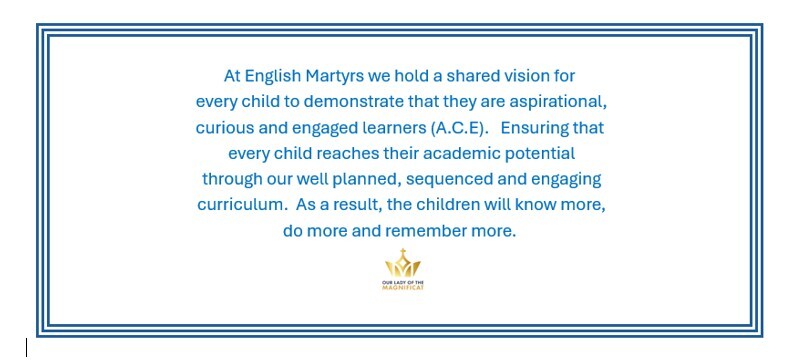- Home
- Curriculum
- Subject Information
- Design Technology
Design Technology

Intent
At English Martyrs Catholic Primary School, we value Design Technology as an important part of the children’s entitlement to a broad and balanced curriculum. Design Technology provides the children with the opportunities to develop and extend skills and an opportunity to apply their knowledge in maths and science in a practical and creative way.
In DT we aim to develop curiosity. We want pupils to ask questions about how things work and how they are made.
We want children to be aspirational in their work. We want them to challenge themselves to create practical artefacts and to develop new skills. Children are expected to be reflective and evaluate their work, thinking about how they can make changes and keep improving.
We want them to be fully engaged in DT lessons, developing a love of experimentation, to think critically about their work.
Implementation
The teaching and implementation of the Design Technology Curriculum at English Martyrs Catholic Primary School is based on the National Curriculum and linked to topics to ensure a well-structured approach to this creative subject.
The children are taught DT as part of their termly topic work. Areas covered include food, textiles, mechanisms, structures and electrical systems. Designing skills are ongoing throughout the school. There is a clear progression throughout the school of key objectives and vocabulary. The DT programme is usually linked to topic work, often to the history, geography or science curriculum
Children in Key Stage 1 and 2 use DT books to record ideas, plan and design their work and review and revise their ideas. Photographs also show the progression and final piece of work. It is usually taught as a block of work over several consecutive days. In Key Stage 1 and 2, pupils take part in 3 units of work throughout the year.
Curriculum Impact
During DT lessons, time is always spent reflecting on work and suggesting ways to develop it further. Pupils are encouraged to critically evaluate their ideas and practical skills and look for ways they can develop them further. They are encouraged to make a practical product for an intended audience and evaluate how successful they have been. Teachers give verbal and written feedback throughout a unit of work.
At the end of each unit of work, teachers assess pupils using the school’s Assessment Grids, indicating whether they are working at the expected level for the year, towards the expected level, or at greater depth.